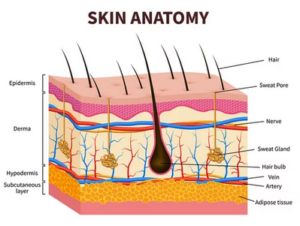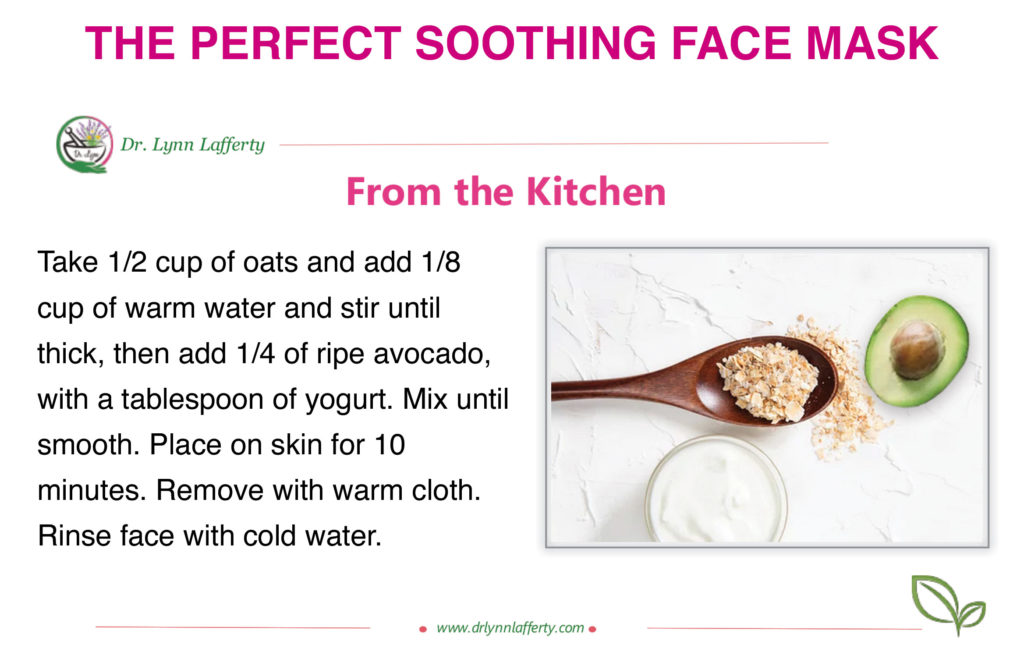The skin is the largest organ of the human body. The skin protects from cold, heat, moisture, microbes and all toxins that could damage the internal structures of the body. It produces sensations, keeps in moisture, releases toxins, makes Vitamin D, and provides a mechanism for absorption of herbs, oils, and drugs. Often problems with the skin can represent other issues within the body.
“An impaired nutritional status alters the structural integrity and biological function of skin, resulting in an abnormal skin barrier. In particular, the importance of micronutrients (such as certain vitamins and minerals) for skin health has been highlighted in cell culture, animal, and clinical studies. These micronutrients are employed not only as active compounds in therapeutic agents for treating certain skin diseases, but also as ingredients in cosmetic products.” (source: National Library of Science)
Different Levels of the Skin
The top level of the skin is called the epidermis and acts as a barrier to protect the body from environmental toxins, infectious microbes and regulate temperature. The epidermis determines how much water to hold or release from the body. It also has beneficial microorganisms that help keep bad bacteria, worms, parasites and viruses at bay. The epidermis is made of keratin, which makes skin, hair and nails tough, and melanin, which gives the skin color.
Although the skin has a high fat content, keratin is made up of protein, biotin (vitamin B7), zinc and vitamin A. It is important to eat foods high in protein and B vitamins (such as meat and green vegetables) and foods with different colors of pigment such as carrots, pumpkin and squash that are high in vitamin A. Melanin can produce age spots from sun exposure and from low adrenal output which is usually caused from high stress over time or viral infections, such as Epstein Barr virus which causes mononucleosis. Using a sunscreen and wearing hats can help reduce the process of age spots Lowering stress can also help keep brown spots at bay.
Calcium is also important to skin as it keeps skin strong and keep its barrier. Zinc is needed for wound healing, protein synthesis and barrier protection, as well as acting as an antioxidant. Eating foods high in zinc like meat, seafood, pumpkin seeds and chickpeas are a great source of zinc.
The second level of the skin is the dermis, which is made from connective tissue, blood vessels, lymphatic sweat glands, nerves, hair follicles, and oil glands. It gives the skin strength and elasticity. The dermis is how the blood carries nutrition to the skin. The connective tissue is made of collagen and elastin. Collagen makes skin strong while elastin makes skin stretchy so it can enlarge or contract as needed. The dermis helps feed the epidermis and is also important for wound healing.
Nutrients needed to make collagen and elastin is protein, vitamin C and E, zinc and copper. When we are under stress the adrenal glands use up vitamin C and this makes less available to the skin; thus causing more wrinkles.
 The hypodermis is the fatty bottom layer of the skin, it may also be called the subcutaneous layer of the skin. It connects all the layers of the skin to bones and muscle as well as providing warmth. It is the biggest area of the skin, and as we age it begins to shrink causing “aging skin.” When skin becomes dry and saggy it may be due to not eating enough healthy fats or the digestive enzymes and bile are not working to digest and absorb fat into the body.
The hypodermis is the fatty bottom layer of the skin, it may also be called the subcutaneous layer of the skin. It connects all the layers of the skin to bones and muscle as well as providing warmth. It is the biggest area of the skin, and as we age it begins to shrink causing “aging skin.” When skin becomes dry and saggy it may be due to not eating enough healthy fats or the digestive enzymes and bile are not working to digest and absorb fat into the body.
Good fats are very important for the skin. These include nuts and nut butters, avocados, cold water fish, yogurt, and even animal fats from organic farm raised animals on sustainable farms.
Toxins That Hurt Our Skin
We Are Exposed to Thousands of Chemicals
While the skin is thought of as a place for protection, it has unfortunately become a place of absorption of toxic chemicals. The CDC says, “It is estimated that more than 13 million workers in the United States are potentially exposed to chemicals that can be absorbed through the skin. Dermal exposure to hazardous agents can result in a variety of occupational diseases and disorders, including occupational skin diseases (OSD) and systemic toxicity.”
They cite, “Workers at risk of potentially harmful exposures of the skin include, but are not limited to, those working in the following industries and sectors:”
- Food service
- Cosmetology
- Health care
- Agriculture
- Cleaning
- Painting
- Mechanics
- Printing/lithography
- Construction
Studies show that absorption of chemicals through the skin can occur without being noticed by the worker, and in some cases, the skin represent the most significant exposure pathway. Many commonly used chemicals in the workplace could potentially result in systemic toxicity, such as pesticides, organic solvents, if they penetrate through the skin. These chemicals enter the blood stream and can cause health problems.
The rate of dermal absorption depends largely on the outer layer of the skin called the stratum corneum (SC). The SC serves an important barrier function by keeping molecules from passing into and out of the skin, thus protecting the lower layers of skin. The extent of absorption is dependent on the following factors:
- Skin integrity (damaged vs. intact)
- Location of exposure (thickness and water content of stratum corneum; skin temperature)
- Physical and chemical properties of the hazardous substance
- Concentration of a chemical on the skin surface
- Duration of exposure
- The surface area of skin exposed to a hazardous substance
Taking Care of your Skin:
- Eat a Healthy Diet: Eat a diet high in phytochemicals which can help detoxify the liver and skin. Eating foods rich in various colors like beets, carrots, dandelions, blueberries, raspberries, and others can help the body rid itself of toxins. Eating foods high in omega 3 fatty acids like walnuts and cold-water fish can help the fat in the skin keep its plumpness.
- Avoid putting anything chemical on the skin: Use natural products like oatmeal, lanolin, coconut oil, lemons, avocados, yogurt, and other herbal food-based products on skin for cleansing, nourishment and protection.
- Eat a diet high in Vitamin A foods. Vitamin A foods such as: Liver, butter, cheese, eggs and carrots help the skin reverse photodamage and aging, and build healthy skin.
- Eat Vitamin C foods: Foods like peppers, oranges, acerola cherries, rose hips, buckwheat and strawberries, provide antioxidant protection helping to remove free radicals caused from the sun and pollution. Vitamin C is needed to which helps make collagen that makes skin strong.
- Eat a diet high in Vitamin E including: Wheat germ, sunflower seeds, almonds and greens. These give antioxidant protection against harmful UV rays and helps repair skin cells.



Recent Comments